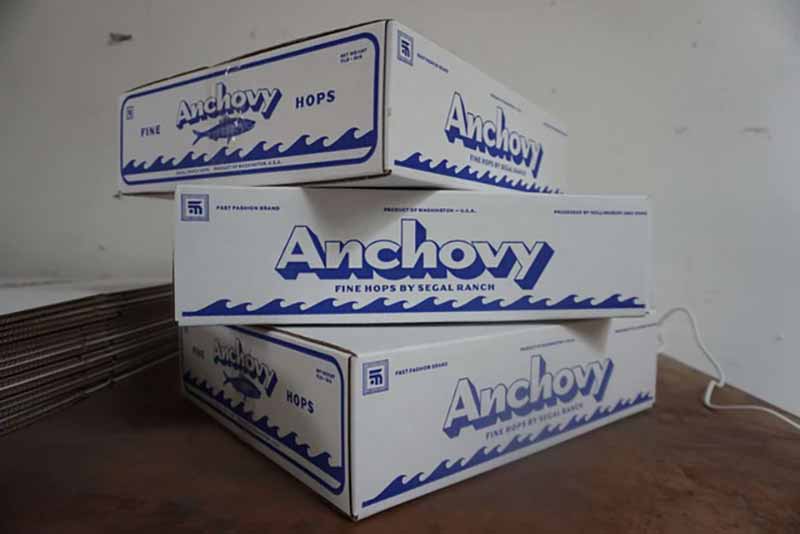
Recently, we wrote about Segal Ranch’s potential home for a new dynamic hop, Zumo. However, the ranch and “master hop whisperer” Martin Ramos aren’t putting all their eggs in one basket. They have other stellar hops, including Anchovy, which, like Zumo, is gaining popularity within the industry.
We chatted with Segal Ranch Owner John Segal and Eighth State Brewing Head Brewer Cameron Owen to learn about Anchovy’s ancestry, the origin of its name, its common characteristics, and where to use it best while brewing.
(Above photography courtesy of Yakima Valley Hops)
Affordable, Industry-Leading Brewery Software
What Are the Ancestry and Analytics of Anchovy Hops?

Graphic courtesy of Yakima Valley Hops
Segal says that getting Ramos to join his ranch as a breeder was a blessing. Ramos, who’s been with Segal Ranch for two decades, previously worked with Chuck Zimmerman, who bred classic American hops Centennial and Cascade.
“Chuck recommended Martin to work here,” Segal says. “We’ve always had a nursery, and Martin continues to breed hops.”
Each year, Segal and his team head into the open-pollination nursery and rub hops to see what they express. Six years ago, they discovered a blend called experimental hop 24B-05.
“Martin loved it,” Segal says. “I wasn’t sure.”
Two years later, Seattle-based Fast Fashion was the first brewery to sponsor acreage for hops, and Segal says the deal had a condition.
“Brian Strumke [and Matt Storm] offered a one-acre sponsorship. It was just what Brian wanted [in a hop],” Segal says. “But he wanted to name the hop, too. He said they were coming out with a beer named Hot Pizza and wanted the hop to be called Anchovy.”
Segal’s initial thought on the name was, “Why not just call it sh*t? Because there’s sh*t, and then the next smelliest thing is anchovies.” But the hop ended up taking off.
“It’s become this whole counterculture,” Segal says. “Forty breweries have brewed with that hop, and it’s been a load of fun.”
Segal has grown the hop to span ten acres. The 2023 Anchovy crop has 11.5% alpha acids and 3.6% beta acids, as well as 1.4% total oils. Anchovy has a high enough alpha acid to be used on the hot side for bittering, but this hop shines bright later in the brewing process to provide distinctive flavor and aroma in the finished beer. Some notes that come through include citrus, sweet fruit, and woody aromatics, according to the Yakima Valley Hops product page. Segal is certain of the hop’s purpose.
“This is an aroma hop for sure,” he says.
What Characteristics Shine in Anchovy Hops?

Photography courtesy of Yakima Valley Hops
No, they don’t smell or taste like anchovies. Quite the contrary.
“I know something like this is subjective,” Owen says. “But I get notes of pine trees and watermelon, with accents of honeydew.”
Owen says questions come up a lot because of the hop’s unique name.
“A lot of people think anchovies are in the beer, but that makes it more fun,” he says. “We get questions like, ‘Is it vegan?’ or ‘Is it salty or fishy?’ That comes up a fair amount.”
Segal says he gets three different elements from the hop.
“It rubs of watermelon, watermelon rind, and a candy fruit necklace,” Segal says. “That all translates into the finished beer.”
Segal says that the hop also plays well with other hops.
According to the Yakima Valley Hops product page, Fast Fashion describes the hop’s characteristics as watermelon hard candy, raspberry, and pine.
When Should You Use Anchovy Hops?

Photography courtesy of Fast Fashion
Segal says the later, the better.
“Whirlpool and beyond,” he says. “Definitely to coax out watermelon and candy fruit flavors and aromas.”
Segal adds, “You can certainly use it as a bittering hop, but you’d be wasting it.”
Owen says the hop can work great in numerous stages of the brewing process.
“Based on how the hop is utilized you can get some pretty traditional profiles that provide almost a chill feeling in the beer,” Owen says. “More specifically, with plenty of hot side addition mid and later on in the boil.”
Eighth State has used Anchovy in several lagers and IPAs. They added Anchovy hot side for their Cold Fish pale lager, which they made in collaboration with Fast Fashion.
“Before this project, we used Anchovy on a couple of IPAs, also with Fast Fashion, which came out great and unique in their own right,” Owen says. “Nothing about this beer felt remotely IPA, which made it perfect for our objectives.”
He adds, “Pairing with something like Citra helps guarantee desired flavor balances based on brewers’ wants.”
Owen says Anchovy also works great when added in the dry hop.
“Utilizing this hop specifically in dry hop allowed us to pull the candied watermelon tangelo profiles met by spruce and pine sap,” he says.
Which Style of Beer Works Best for Anchovy Hops?
Segal notes an “impressive list of breweries that have brewed with Anchovy.” He says Stone Brewing plans to release a hazy double IPA featuring the hop this summer.
“Anchovy leans towards IPAs and hazies,” Segal says. “Could it be in a lager? Absolutely. But [for] that watermelon and candy, it’s best for IPAs and double IPAs.”
Owen says they’ve used Anchovy in just two styles.
“Both styles have shown to be equally awesome in their own right,” Owen says. “IPA and pale lager is the way to go.”



